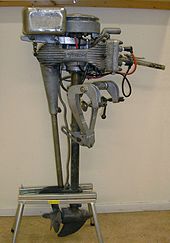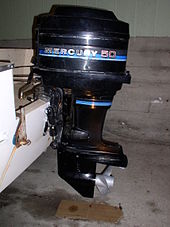
Back Buiteboordmotor Afrikaans محرك خارجي Arabic Forabord Catalan Außenbordmotor German Motor fueraborda Spanish Päramootor Estonian Karelez kanpoko motor Basque موتور قایقرانی Persian Perämoottori Finnish Hors-bord French
This article needs additional citations for verification. (April 2012) |

An outboard motor is a propulsion system for boats, consisting of a self-contained unit that includes engine, gearbox and propeller or jet drive, designed to be affixed to the outside of the transom. They are the most common motorised method of propelling small watercraft. As well as providing propulsion, outboards provide steering control, as they are designed to pivot over their mountings and thus control the direction of thrust. The skeg also acts as a rudder when the engine is not running. Unlike inboard motors, outboard motors can be easily removed for storage or repairs.



In order to eliminate the chances of hitting bottom with an outboard motor, the motor can be tilted up to an elevated position either electronically or manually. This helps when traveling through shallow waters where there may be debris that could potentially damage the motor as well as the propeller. If the electric motor required to move the pistons which raise or lower the engine is malfunctioning, every outboard motor is equipped with a manual piston release which will allow the operator to drop the motor down to its lowest setting.[1]
- ^ Wordford, Chris (3 July 2008). "Outboard Motors". Retrieved 9 February 2012.